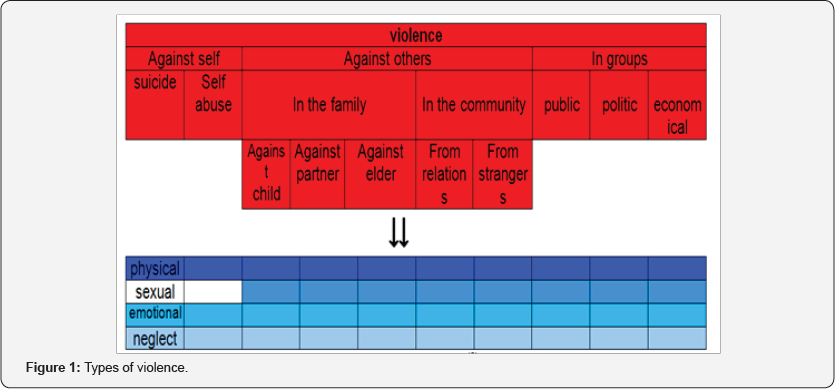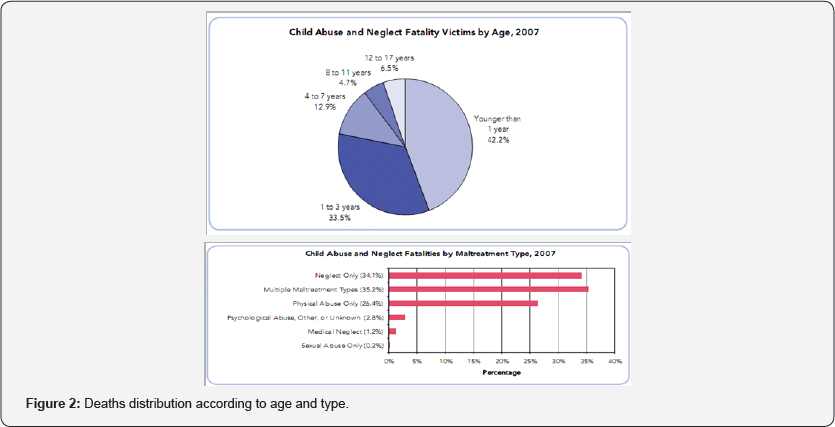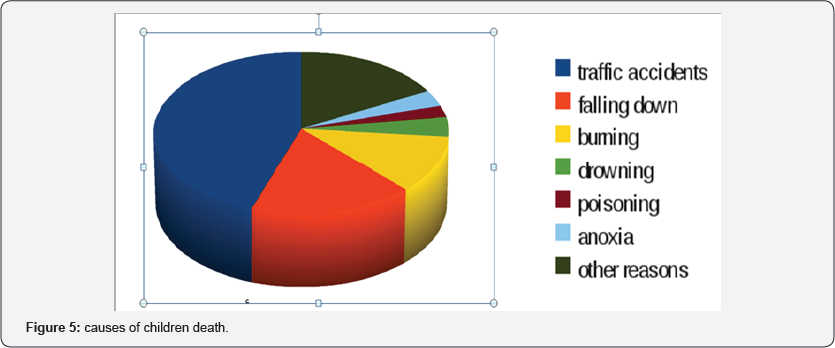Causes of Children Death in Damascus & Probability of Abuse or Neglect
Alsaraqiby A*
Department of forensic odontologist, Damascus university, syria
Submission:August 25, 2017; Published: September 22, 2017
*Corresponding author: Alsaraqiby A, Department of forensic odontologist, Damascus university, Syria, Email: syrforden@yahoo.com
How to cite this article: Alsaraqiby A. Causes of Children Death in Damascus & Probability of Abuse or Neglect. Int J cell Sci & mol biol. 2017; 3(3): 555611. DOI: 10.19080/IJCSMB.2017.03.555611.
Abstract
Violence is a phenomenon that exist in all societies, but it's prevalence and incidence is still unstudied in Arabian societies . The current research analyses the causes of death of the children in Damascus and estimating the distribution of fatal CAN cases. The method of the research was retrospective study of the records of the justice palace of registered deaths during last 5 years. The sample included 968 death cases, 644 male and 324 female, primal cause was traffic accidents which caused the death of 45% of the cases, then falling caused 17% and burning caused 11.6%. The cases that were registered as a fatal CAN were just 0.6% which indicates that these cases are not being detected sufficiently.
Counterchecking the records we expected 287 case to be probable CAN case, the primal cause was neglect (70-80%) then physical abuse (17-27%) and emotional abuse (1-5%). Sexual abuse didn't appear in the records as a cause of death. Correlation between abuse and gender was weak in the sample.
Introduction & Definitions
Violence is being obviously seen worldwide day after day, and awareness of it is increasing . It is a fact that diagnosis is the first step it treating any disease, so the whole word was concerned to detect the prevalence of this phenomenon and its consequence.
The world report on violence and health defined violence to be:"intentional use of force or threatning with it, against oneself another person or against a group or community, that either results in or has a high likelihood of resulting in injury, death, psychological harm ,mal development or deprivation [1].

According to the definition we can identify the following types of violence, physical, emotional, sexual, & neglect. It was also divided to a wide range including child abuse & neglect, elder abuse, and self abuse (Figure 1). In this study we will concern at a certain type of violence which is child abuse and neglect (CAN), and from its consequences we will study cases that caused death. Physical abuse is violence that causes physical injuries (abrasion, bruises, wounds, fractures) [2]. Emotional abuse is continuous pattern of extremist acts or behaviour by caregiver that convey to a child that he is flawed , menaced , unloved , undesired , worthless or only of value to meeting another's needs [3]. Sexual abuse is any act or behavior with a child which has sexual bearing [4]. Neglect is failing to provide for essential needs of a child (cloths, shelter, health, feeding, learning, supervision) in case were this failure is not due to poverty or disability [2]. A child is each individual whose age didn't exceed 18 year [5].
Rational
The national child abuse & neglect data system in USA (NCANDS) reported 1760 death of children during 2007 as a result of CAN, meaning that 2.35 from 100000 are victims of CAN which causes death [6]. This system also found that this number has been increasing during the last five years , which is a result of improvement in documenting and reporting these cases. The distribution of these deaths is demonstrated in Figure 2. In many countries such data are not available, because of the absence of child protecting services that document and report such cases [6,7].

Available studies in Syria: The rate of children death less than 5 years age is 14/1000, and thus according to UNICEF, it comes the 130th when arranging the world countries [8]. The high percents were respiratory infections and diarrhea as reported in Mics 2006 done by Syrian CBS (central bureau for statistics) in cooperation with Syrian Ministry of health and UNICEF [9].
Ministry of law enforcement reported that traffic accidents during 2006 caused the death of 737 children [10]. A local study found that 10.4% of the accidents occur to childes, half of which occurs in their home, and the majority of them are caused by falling [11]. A study made by Syrian ministry of health in 2008 about cases of children death under 5 years age involved 78420 family , it reported that the main cause was birth defects (28.8%), followed by respiratory infections (including pneumonia) (15.3%), then by diarrhea in the third place (12.6%). All these researches didn't study the deaths caused by CAN, or the causes of not noticing them, neither they suggested the importance of detecting their prevalence. A child death because of CAN must alert us that there is a family to treat and other children in it to protect.
Methods
Prospective study of registered deaths in justice palace of Damascus since 1/1/2005 till 1/1/2010 for individuals whose age didn’t exceed 18 year (as the definition of child in Syrian law). Damascus is the capital of Syria, it's population are about 4 million individual, which is about 21.5% of the population of the whole country [13]. The child's percentage in 1981 was 56%, it retracted in 2004 to 49%. During 2009 about 869 child die as registered in burying bureau (Figure 3).
These cases are reported by a non-specialized physician, and the report doesn’t include the findings, tests, or history.Deaths that are documented in justice palace of Damascus are ones that result from accidents (traffic accidents, falling down.) or suspicious deaths (in hospital or in home but the death reasons is not clear). The sample included 968 reported cases (644 male and 324 female), each include the examination of forensic examiner, the judge findings, and witnesses testimony. These records didn't include any tests to detect if there was any evidence of CAN or not. So in this study every report of a case suspects the CAN (according to the history or the examination) was considered as probable child abuse/neglect. We couldn't prove CAN because we couldn’t examine the cadavers that are buried, skeltonized or decomposed comparing the distribution in of children death registered in justice palace (Figure 4) with children death registered in burying bureau (Figure 3), we find that much dead children under 1 year of age are not examined by a forensic physician, due to the high percentage of death because of birth defects, respiratory infections and diarrhea as reported in MICS 2006 [9]. The deaths are usually reported by a general physicians. We remind with the importance of detecting fatal CAN in this year as the data of child death due to abuse and neglect in USA shows that 42.2% take place in this year. We also find that high percentage of child death in age 15-18 are accidental (traffic accidents, falling down, job injuries ... ) [7] (Figure 5).



Causes of children death
Reported fatal CAN cases: 6 cases during the last five year (0.6 % of the cases) wich indicates the underestimating of fatal CAN . These cases were only the cases were abuse consequences were very obvious, or a side pursued legal action on the case.
1) A child aged 13, die because of depressed fracture in the top of the skull associated with subdural haemorrhage, the history (by stepmother) was falling of the child. The mother imputed the stepmother to cause the death of the child, so it was examined by a forensic physician how find multiple bruises and a bitemark, and hence it was concluded that the death was a result of physical abuse.
2) 2 years aged girl die because subdural haemorrhage, the history was falling inside the home, but forensic examination showed multiple bruises, bitemark and teared liver. And so proved physical abuse.
3) 3 years aged girl die due to hemorrhagic pancreatitis as result of trauma to the abdomen, the father imputed the stepmother to cause the death, and that was proved by forensic examination.
4) 3 years aged boy die because of subdural haemorrhage. The caregivers mentioned a history of falling, but forensic examination proved the death to be a result of physical abuse finding bruises with different ages.
5) 2.5 years aged girl die because of subdural haemorrhage, findings were optical nerve edema and multiple bruises, so death was considered as a result of physical abuse (hitting by father).
6) 2 months aged girl die because of traumatic injury of the brain result from hitting by her father ( as the mother mentioned) . By examining the father he was psychiatric patient.
Traffic accidents deaths: This was the highest percentage death cause in the sample (45%, 438 child death). Figure 6 for the distribution of deaths by age, these accidents increased in summer & spring (49 case in august), an decreased in winter & autumn (Figure 7).


According to the history written in the report we considered the death as a result of neglect if a child under 10 was without supervision, a child under 12 crossing autostrada without supervision, handicapped child without supervision, or child riding motorcycle. These include 76 cases (17%), Figure 8 shows their distribution by age.
Falling deaths
These include 168 case (17.4%). we divided them according to the history to 28 neglect cases (child without supervision, handicapped child, or doing jobs don't suit the age), 38 probable physical abuse cases (multiple old bruises, associated findings such as burns, nails abrasions, or finger marks, or injury’s severity don't suit the history) and the other cases were considered accidental (history mentioned in the report isn't suspicious of CAN) (Figure 8 & 9).
Burns deaths
These include 112 case (11.6%), they were divided according to the history into 3 parts, 47 case of death as a result of neglect (child without supervision, handicapped child, injury of a job that doesn't suit his age, or delayed seeking medical care in severe cases), 4 cases of probable physical abuse (associated suspicious injuries, or the age doesn't suit the history told by caregiver) and 3 cases of probable emotional abuse (suicide). The other cases were considering accidental (nothing in the report suspect CAN). Figure 10 Sinking deaths were 38 cases, included 14 cases of neglect and 4 cases of probable physical abuse.




Poisoning deaths were 23 cases, included 15 cases of neglect and 4 cases of probable emotional abuse (suicide) anoxia deaths were 32 cases, included 4 cases of neglect, 5 cases of probable physical abuse, and 4 cases of probable emotional abuse deaths from other reasons (electric shock, congenital deformities, foundling death.) were 167 cases included 31 cases of neglect and 14 cases of probable physical abuse thus, cases of neglect were 215 cases of probable physical abuse them were registered. Cases of probable emotional abuse were 8. This type of abuse is difficult to detect, so apparent cases percentage would be much less than real prevalence. Fatal sexual abuse is very rare and was not seen in the sample. Male death cases were 176 (61.3%) while female death cases were 111 (38.7%). Figure 11 shows the distribution of probable fatal CAN in the sample Table 1.

Chi value = 5 so there is no correlation between gender and fatal CAN, but this correlation appear for α=0.01
For α = 0.05 the expected distribution of fatal CAN would be:
Neglect would cause 70-80%
Physical abuse would cause 17-27%
Emotional abuse would cause 1-5%
Male victims would be 55-67%
Female victims 33-45%
References
- Krug E, Dahlberg L, Mercy J, Zwi A, Lanzo R (2002) World report on violence and health. Geneva: World Health Organization.
- Essali MA (2008) Protecting Syrian children from abuse and neglect. Syrian high education ministry, high institute for demographic studies and researchers.
- Al Mahroos FT (2007) Child abuse and neglect in the Arab Peninsula. Saudi Med J 28(2): 241-248.
- US Department of Health and Human Services (2002) Administration on Children, Youth and Families: Child maltreatment 2000. US Government Printing Office, Washington DC, USA.
- (1993) Human Rights: International muniments, part 1 UN Newyork, USA, P. 237.
- Cornell university (2008) Family life development center : National child abuse and neglect data system.
- UNICEF (2007) Child situation in the world 2008: Children surviving. United nation plaza, New York, 10071 USA p. 114.
- (2007) Ministry of law enforcement: statistical report for traffic.
- Bashour H, kharouf M (2001) Social study of accidental injuries in pre-school children of Damascus.
- The Ministry of Health, primary health care, Causes of Death among Children Under Five Years of Age, 2008 CBS, 2007 pp. 57-77.
- (2010) Damascus burying deaths bureau records.






























